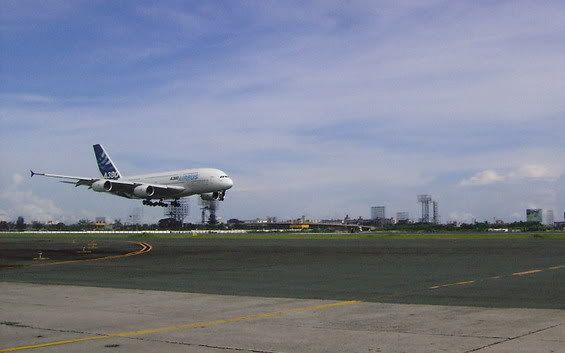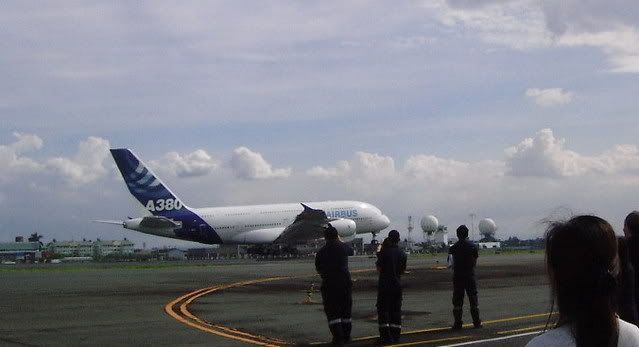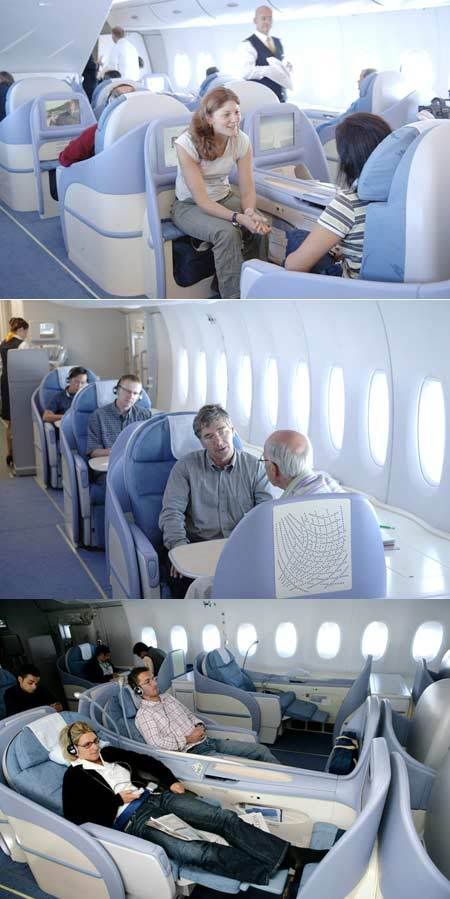The world’s largest commercial aircraft, the Airbus A380, will fly over the skies of Metro Manila on Oct. 11 before landing at the Ninoy Aquino International Airport (NAIA) for the first time.
Local aircraft enthusiasts will have a closer look at the super jumbo jet which is scheduled to arrive at 2:45 p.m. and land at the NAIA’s longest runway, the 3,700-meter long 06/24 runway.
The giant aircraft, which requires only 1,500 meters of landing space, will line up for its final approach in the vicinity of Antipolo flying toward the South Luzon Expressway.
The aircraft can be clearly seen at The Fort in Taguig City but can be best viewed at the east-west service roads of the South Luzon Expressway near the gates of Villamor Airbase and Merville Subdivision.
Upon loading, the double-deck aircraft will taxi toward NAIA’s remote parking area where officials from the Airbus 380 Industries as well as Manila International Airport Authority officials, to be led by MIAA general manager Alfonso Cusi and other airline companies, will be waiting for a tour of the aircraft’s interiors.
The state-of-the-art aircraft will dock at an exiting gate of the NAIA to check if the A380 Airbus can utilize the existing movable bridges of the terminal.
Manila is part of the aircraft’s test flight technical route.
The aircraft, with tail MSN009, will also visit other countries, which include South America, the Middle East and Asia-Pacific.
The series of tours is also a certification exercise aimed at accumulating 150 hours of “typical airline” continuous operation using the new Engine Alliance GP7000 engines manufactured by General Electric and Pratt and Whitney.
From its home base in Toulouse, France, the aircraft left for Bogota in Colombia last Sept. 24, flying back the following day. From Oct. 2 to 5, it will fly to the United States, landing at Hartford, Connecticut; Cincinnati and San Francisco, California.
The Airbus A380 is much cleaner, quieter, greener and smarter than any other air transport in the world. It is more fuel-efficient than a small car that it can only consume 2.9 liters of fuel for every 100 kilometers traveled.



Local aircraft enthusiasts will have a closer look at the super jumbo jet which is scheduled to arrive at 2:45 p.m. and land at the NAIA’s longest runway, the 3,700-meter long 06/24 runway.
The giant aircraft, which requires only 1,500 meters of landing space, will line up for its final approach in the vicinity of Antipolo flying toward the South Luzon Expressway.
The aircraft can be clearly seen at The Fort in Taguig City but can be best viewed at the east-west service roads of the South Luzon Expressway near the gates of Villamor Airbase and Merville Subdivision.
Upon loading, the double-deck aircraft will taxi toward NAIA’s remote parking area where officials from the Airbus 380 Industries as well as Manila International Airport Authority officials, to be led by MIAA general manager Alfonso Cusi and other airline companies, will be waiting for a tour of the aircraft’s interiors.
The state-of-the-art aircraft will dock at an exiting gate of the NAIA to check if the A380 Airbus can utilize the existing movable bridges of the terminal.
Manila is part of the aircraft’s test flight technical route.
The aircraft, with tail MSN009, will also visit other countries, which include South America, the Middle East and Asia-Pacific.
The series of tours is also a certification exercise aimed at accumulating 150 hours of “typical airline” continuous operation using the new Engine Alliance GP7000 engines manufactured by General Electric and Pratt and Whitney.
From its home base in Toulouse, France, the aircraft left for Bogota in Colombia last Sept. 24, flying back the following day. From Oct. 2 to 5, it will fly to the United States, landing at Hartford, Connecticut; Cincinnati and San Francisco, California.
The Airbus A380 is much cleaner, quieter, greener and smarter than any other air transport in the world. It is more fuel-efficient than a small car that it can only consume 2.9 liters of fuel for every 100 kilometers traveled.



No comments:
Post a Comment